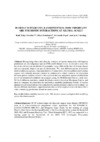Identificador persistente para citar o vincular este elemento:
https://accedacris.ulpgc.es/jspui/handle/10553/122132
| Campo DC | Valor | idioma |
|---|---|---|
| dc.contributor.author | Triay Portella, Raül | en_US |
| dc.contributor.author | Fernández, Marc | en_US |
| dc.contributor.author | Tuya, Fernando | en_US |
| dc.contributor.author | Canning- Clode, João | en_US |
| dc.date.accessioned | 2023-04-27T10:14:40Z | - |
| dc.date.available | 2023-04-27T10:14:40Z | - |
| dc.date.issued | 2023 | en_US |
| dc.identifier.isbn | 978-84-9042-477-3 | en_US |
| dc.identifier.uri | https://accedacris.ulpgc.es/handle/10553/122132 | - |
| dc.description.abstract | Recognizing where and when the inclusion of species interactions will improve predictions on non-indigenous species (NIS) establishment would be critical to assess bio invasions and accurate prediction of geographic range shifts in the face of climate change and anthropogenic impacts on species interactions. We used different species of invasive crabs (Callinectes sapidus, Charybdis hellerii, Cronius ruber, Percnon gibbesi and Portunus segnis) with different invasion histories to understand in which scenarios the interaction between species could be a driver in the success of the non-indigenous species establishment even if environmental conditions are adequate, using the Mediterranean Sea as a study case. We built different correlative spatial distribution models based on Maximum Entropy and then we compared invasion histories and habitat suitability predictions. Finally, if species interactions are important in some scenarios of a species realised niche but not in others, we discuss different mechanistic approximations that could be adaptive to include these effects when formulating predictions around invasion success. | en_US |
| dc.language | eng | en_US |
| dc.publisher | Servicio de Publicaciones y Difusión Científica de la Universidad de Las Palmas de Gran Canaria (ULPGC) | en_US |
| dc.source | Abstracts Volume VIII International Symposium on Marine Sciences, July 2022 / coordinación, María Esther Torres Padrón, p. 171 | en_US |
| dc.subject | 251005 Zoología marina | en_US |
| dc.subject | 240106 Ecología animal | en_US |
| dc.subject.other | Habitat suitability | en_US |
| dc.subject.other | Invasive crabs | en_US |
| dc.subject.other | NIS | en_US |
| dc.subject.other | Invasion success | en_US |
| dc.subject.other | Ecological niche modelling | en_US |
| dc.subject.other | Species distribution models | en_US |
| dc.title | Habitat suitability & competition: how important are the biotic interactions at global scale? | en_US |
| dc.type | info:eu-repo/semantics/lecture | en_US |
| dc.type | Lecture | en_US |
| dc.relation.conference | VIII International Symposium on Marine Sciences (ISMS 2022) | en_US |
| dc.description.firstpage | 171 | en_US |
| dc.investigacion | Ciencias | en_US |
| dc.type2 | Ponencia | en_US |
| dc.description.numberofpages | 1 | en_US |
| dc.utils.revision | Sí | en_US |
| dc.identifier.ulpgc | Sí | en_US |
| dc.contributor.buulpgc | BU-BAS | en_US |
| dc.contributor.buulpgc | BU-BAS | en_US |
| dc.contributor.buulpgc | BU-BAS | en_US |
| dc.contributor.buulpgc | BU-BAS | en_US |
| item.grantfulltext | open | - |
| item.fulltext | Con texto completo | - |
| crisitem.event.eventsstartdate | 06-07-2022 | - |
| crisitem.event.eventsenddate | 08-07-2022 | - |
| crisitem.author.dept | GIR ECOAQUA: Biodiversidad y Conservación | - |
| crisitem.author.dept | IU de Investigación en Acuicultura Sostenible y Ec | - |
| crisitem.author.dept | GIR ECOAQUA: Biodiversidad y Conservación | - |
| crisitem.author.dept | IU de Investigación en Acuicultura Sostenible y Ec | - |
| crisitem.author.dept | Departamento de Biología | - |
| crisitem.author.orcid | 0000-0002-7591-6254 | - |
| crisitem.author.orcid | 0000-0001-8316-5887 | - |
| crisitem.author.parentorg | IU de Investigación en Acuicultura Sostenible y Ec | - |
| crisitem.author.parentorg | IU de Investigación en Acuicultura Sostenible y Ec | - |
| crisitem.author.fullName | Triay Portella,Raül | - |
| crisitem.author.fullName | Tuya Cortés, Fernando José | - |
| Colección: | Ponencias | |
Visitas
129
actualizado el 16-nov-2024
Descargas
51
actualizado el 16-nov-2024
Google ScholarTM
Verifica
Altmetric
Comparte
Exporta metadatos
Los elementos en ULPGC accedaCRIS están protegidos por derechos de autor con todos los derechos reservados, a menos que se indique lo contrario.
